How to Revive St. Augustine Grass and Get it to Grow Back
During late winter and early spring, St. Augustine grass can get burned up with frost and appear dead. A once green lawn will appear to have dead grass that’ll take some effort to bring back to life. So, how can you revive St. Augustine grass?
Water St. Augustine grass with 1-1.5 inches of water every week to revive it quickly. Apply nitrogen fertilizer and grub control, then mow the lawn high at 3 inches to make the grass green again. If the grass is dead, install new sod to revive and bring the lawn back to life.
St. Augustine grass can turn brown and die due to drought stress, fertilizer burn, dormancy, poor soil quality, or grub damage. A brown St. Augustine lawn that appears dead can also be a sign your grass is still in dormancy or is suffering from frost burn. To fix get the grass to turn green fast, you have to address these causes.
Table of Contents
Can you revive dead St. Augustine grass and bring it back?
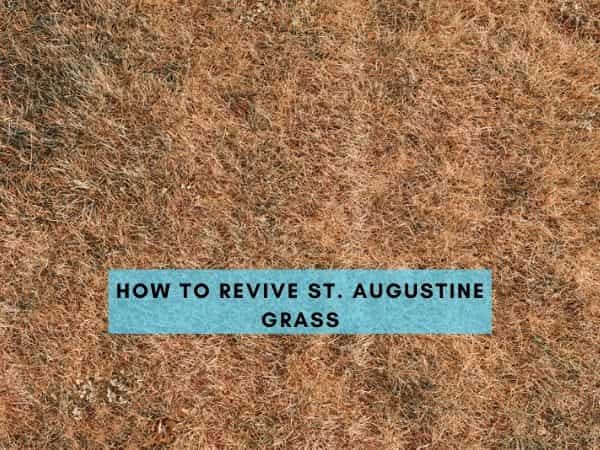
You can revive grass that appears dead due to drought stress or frost burn, but you cannot bring back grass if it is completely dead due to grubworm damage or lack of water. You can revive dormant grass within a few weeks of proper care and maintenance.
But first, examine the grass to see if it is dead or still alive. Grab a handful of the brown grass and pull it up. If the grass comes out without any resistance, it is dead and cannot be revived. If it is still firm, you can bring it back to life.
Reasons St. Augustine Grass Appears Dead
Poor lawn care and maintenance can cause a St. Augustine grass lawn to appear dead due to the extended brown patches. In some instances, browning does not mean the grass is dead.
Here are the reasons your St. Augustine grass is turning brown or dead:
Grub damage
More than 5-10 grubs per square foot in your lawn is a sign of grub infestation that will soon manifest in expanding brown patches in your lawn. Grubworms feed on the roots of your St. Augustine grass lawn, causing it to die in patches because it cannot absorb water and nutrients anymore.
Grub damage in a St. Augustine lawn, or any other grass species turfgrass, shows as irregularly shaped brown patches of dead grass that never green up despite all the watering.
The brown patches of dead grass start to appear in late spring through summer to early fall when Japanese beetles are in their larva stage. To prevent dead St. Augustine grass during this time, apply grub control early in spring to kill the larvae before they become active and start to damage your lawn.
Frost damage
St. Augustine grass can spread and grow green and then turn brown and appear burned during late winter and early spring due to frost damage. While the signs of frost damage vary between grass species, St. Augustine grass turns brown quickly and can become patchy.
In most cases, you’ll be able to revive St. Augustine grass, but if the damage is too extensive and the grass is dead, you may need to plant a new sod to restore it. For other turfgrasses such as bermudagrass, overseeding in the fall usually helps fill in and green up the lawn.
Frost damage can be worse if you mow your lawn too low in the fall. The lawn will end up with a lot of dead, matted down areas that you can even rake off to remove the dead grass.
Drought stress
Inadequate soil moisture in your St. Augustine lawn can lead to signs of drought stress, which include brown dead grass, slow growth, and wilting. Signs of drought are common in summer when temperatures rise and there’s little to no rain water.
If your St. Augustine goes for more than 6 weeks without water, it will start to turn brown and show signs of death. If you start fixing the lawn early enough, you’ll be able to get St. Augustine grass to grow back and revive with a good watering schedule – usually 2-3 times a week.
Dormancy
During winter, your lawn goes into dormancy and may appear to turns brown or tan in color until springtime. Typically, St. Augustine grass will go dormant when the soil temperatures start to fall below 55 degrees.
Too much desiccation during dry winters is a common problem especially in water-sensitive varieties of turfgrass such as St. Augustine grass. However, you can bring back the grass by watering the lawn during winter so that when spring comes, the grass isn’t dead.
Fertilizer burn
Fertilizer burn means that you applied excess fertilizer to your lawn. Putting down more than 1 lb of nitrogen per 1000 square feet can cause signs such as withering, browning, and yellowing St. Augustine grass. If the fertilizer burn is too much, your grass will start to die.
Many lawn fertilizers contain soluble salts. These salts can burn root tissues and cause your lawn to turn brown or discolor if fertilizer is applied in excess. Here are the signs of fertilizer burn on your lawn:
- Leaf scorch due to excess nitrogen and salts.
- Leaf tips starting to turn brown.
- Lower leaves of grass turning yellow.
- A crust of fertilizer on the surface of soil in your lawn.
The good news is that with early intervention, you can revive dead St. Augustine grass and bring it back to life after applying excessive fertilizer.
Poor soil quality
St. Augustine grass tolerates a few types of soil if there’s adequate fertility, aeration, and moisture. However, poor soil quality can cause the grass to die and turn brown.
For example, a lawn with a thin layer of topsoil and concrete, gravel, or rocks underneath could be the reason why St. Augustine grass is dying. Also, heavily compacted clay soil prevents roots from growing deep for proper nutrient and water absorption, causing the grass to die slowly.
Poor soil quality can be fixed with soil amendment methods to get St. Augustine grass to grow back. You’ll also need to ensure that the soil pH and nutrient levels are within the right range to be able to revive and bring back St. Augustine grass to life.
Lawn diseases
St. Augustine lawn diseases such as fungus or brown patch disease can cause your lawn to appear dead with areas of brown patches. If you see regular rings of dead grass and rusty-looking growths in a St. Augustine lawn, followed by yellowing and browning, you’re probably dealing with brown patch disease.
Lawn diseases are prevalent during fall and spring because the weather is warm and humid, creating a good environment for fungi to grow and spread in lawns. Take-all root rot and gray leaf spot can attack a St. Augustine lawn and make it appear brown and brown with dead patches.
You can revive dead St. Augustine grass by treating lawn diseases on time by applying an anti-fungal treatment (with azoxystrobin as the active ingredient, such as Scotts DiseaseEx Lawn Fungicide) that’ll bring the dying grass back to life.
How to Revive St. Augustine Grass to Grow Back
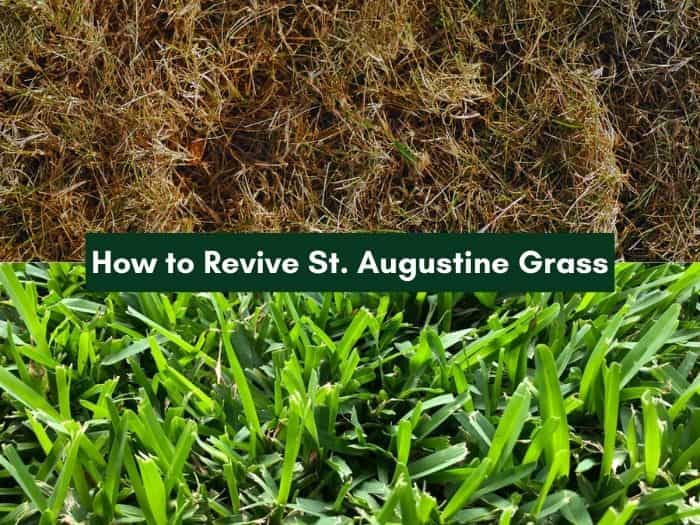
To revive your lawn and make it grow back, you need to identify what’s killing the grass and turning it brown. A drought problem can easily be fixed by watering your lawn as required but a pest and disease problem may take a different approach to fix.
Here’s how to revive St. Augustine grass and get it to grow back:
1. Water the lawn adequately
Prolonged drought and dormancy can make St. Augustine grass start to die off in small patches that turn brown. Watering your lawn adequately can help get it to grow back steadily.
Here are the watering requirements for St. Augustine lawns:
- How much water: ¾ inch of water
- Watering frequency: 2 times per week
- Growing season: 1-2 inches of water
- Drought season: up to 6 inches of water
Once St. Augustine grass starts to get out of dormancy, water adequately to help revive any brown patches of dying grass. During spring, water the lawn a little bit more frequently than when the grass was still in dormancy.
Pro tip: Watering grass that has been dead for 3 weeks can bring it back and turn it from brown to green. Try watering to a depth of 6 inches to reach the roots and allow the grass to grow back and green up. You might, however, not be able to revive a lawn that’s been dead for more than 5 weeks.
2. Amend the soil in your yard
When a thin layer of topsoil or highly compacted clay soil causes your grass to wilt, turn brown, and die, the best remedy is to improve the soil quality.
The best fix for poor soil quality is to amend the soil to make it suitable for St. Augustine grass to grow healthy. The goal is to make sure the lawn is well aerated because St. Augustine grass likes a to grow in well-draining soils such as sandy soil.
Here’s how to amend the soil to revive a St. Augustine lawn:
- Amend clay soil by adding gypsum, compost, or humic acid.
- Core-aerate the lawn if the grass is drying from compaction.
- Add enough fertile topsoil to provide a medium for roots to grow deep.
When amending the soil in your yard to get the dead grass to grow back, do a soil test to see if the soil pH and nutrient levels are great for St. Augustine grass.
3. Flush out excess salt from overfertilization
Fertilizer burn can make your lawn look like it is dying. The grass starts to turn yellow and then brown as if it is dead.
To revive and get St. Augustine grass to grow back from too much fertilizer, water with a generous amount of water to flush out the excess nitrogen salts that are burning the grass. Soak the areas that are turning brown with water everyday for a week to get rid of the excess salt.
- Water the lawn with at least 1 inch of water per day to reduce fertilizer burn.
- Water the lawn evenly with a sprinkler to allow the grass to grow back uniformly.
Be careful not to overwater your lawn because it can lead to other problems such as fungal infections, yellowish or light-green coloring, and poor growth.
4. Apply a grub killer
Too many grubs in your lawn feed on the grass roots leaving the grass to die and turn into brown patches of dead grass. If the damage is not too much, you can get the lawn to grow back by killing the offending grub worms.
Examine the lawn to check for grubs and then apply a good grub killer such as Scotts GrubEx, BioAdvanced Grub Killer Granules, or Milky Spore Grub Control. Any of these will kill the active grubs and allow St. Augustine grass to revive and grow back.
Pro tip: The best time to apply a grub control pesticide is between early spring and late summer. This is when there’s increased grub damage in the lawn.
5. Re-sod your lawn
The best way to revive St. Augustine grass that’s been dead for over 5 weeks is to reseed. When winter ends and spring kicks in, prepare the yard and establish a new lawn using St. Augustine sods since there’s no grass seed for this species.
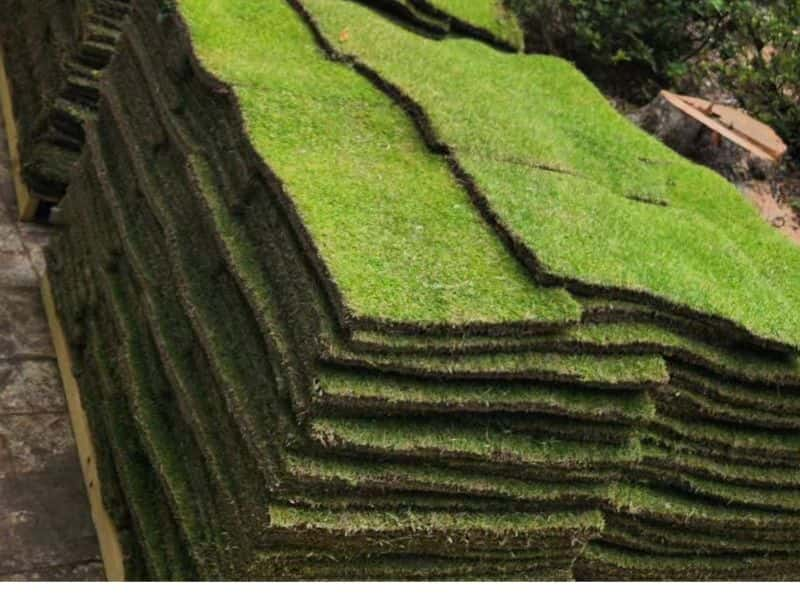
Re-establishing your lawn can help restore a lawn to its green appearance especially if the grass died due to extreme drought or winter kill, also known as frost burn or frost damage.
If there are only a few spots of dead grass, you can will in with sods or sprigs and make the St. Augustine grass to spread and cover the bare spots.
6. Treat brown patch disease
Brown patch disease is a fungus that affects lawns when they remain wet for prolonged periods. If not prevented and treated on time, your lawn will develop brown patches of dead grass that might be difficult to revive.
As soon as you see signs of brown patch disease in St. Augustine grass, start applying an Azoxystrobin fungicide such as Scotts DiseaseEx or Syngenta Heritage G that’ll kill the fungus and revive your lawn.
Here’s a great video on how to treat brown patch disease and get St. Augustine grass to grow back greener.
Sources + References
- Clemson University Cooperative Extension: St. Augustinegrass Yearly Maintenance Program
- University of Maryland Extension: Fertilizer Injury in Lawns
- L. E. Trenholm, J. B. Unruh, and T.W. Shaddox, University of Florida IFAS Extemsion: St. Augustinegrass for Florida Lawns

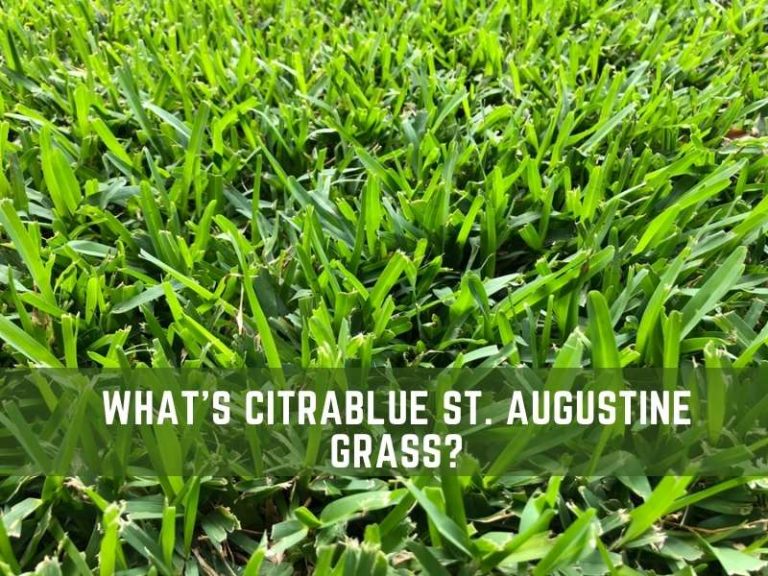

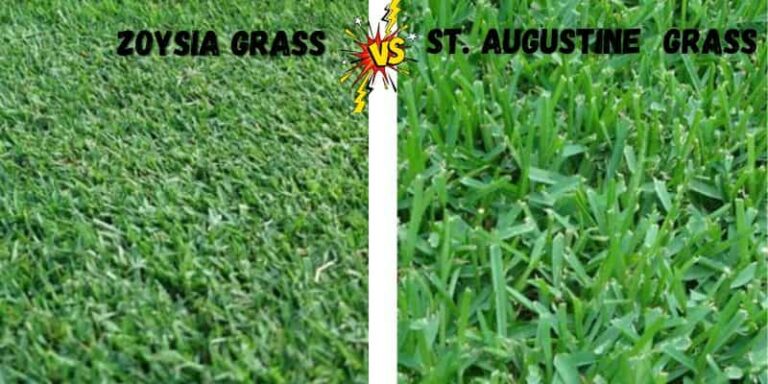

My Bitter Blue St Augustine yard has been installed for five years. I have had again this year a very lush yard but starting in early August, my yard quickly tanked. My yard for most of this year although lush, has had an inordinate amount of brown thatch (brown blades). This condition preceded , not specifically “brown spot” residue which I have dealt with for 3 or 4 years. When I raked (by hand) to clear the thatch build up, the area would very quickly build back-up with thatch. Also. when I raked these spots, I would have an inordinate amount of green grass stems along with the brown stems. I thought my root system was under attack by web worms or the like …. Treated for sod-web-worms. Please advise and I would be glad to provide additional info. thank you
St. Augustine does hold well in fall and tends to hold on well into winter, especially when protected well by layers of leaves. However, it is affected by cold weather, more so the soil temperature. St. Augustine grass goes dormant (fall and winter months when the temperature drops)-it will turn brown and stop growing but will grow again in the spring when the temperature rises. In addition, pest and disease infestation can cause this too. More info would help